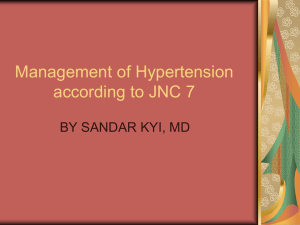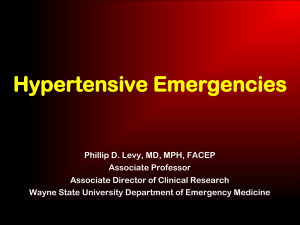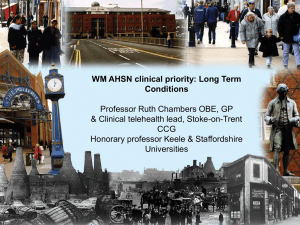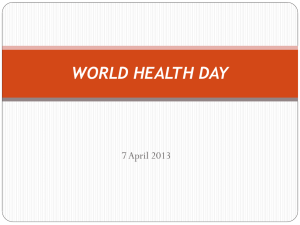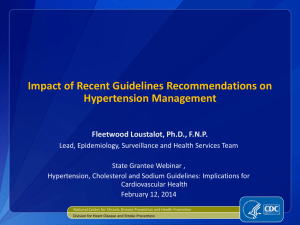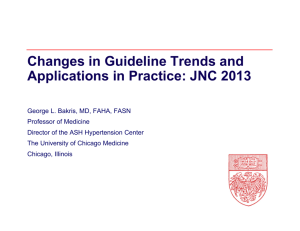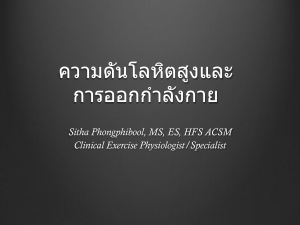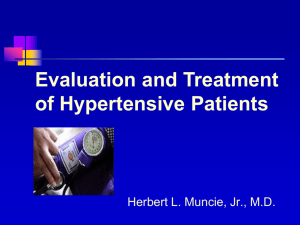Ways to Reduce Nervousness
advertisement
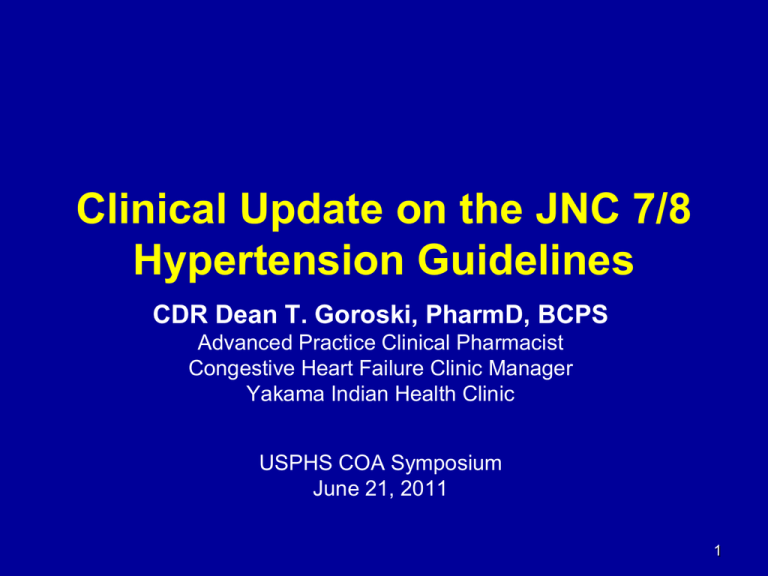
Clinical Update on the JNC 7/8 Hypertension Guidelines CDR Dean T. Goroski, PharmD, BCPS Advanced Practice Clinical Pharmacist Congestive Heart Failure Clinic Manager Yakama Indian Health Clinic USPHS COA Symposium June 21, 2011 1 Disclosures • I have hypertension • I work with people who have hypertension 2 Overview • Discuss potential changes to the JNC hypertension guidelines and the rationale behind these changes. • Describe strategies to help implement antihypertensive regimens with greatest chances of success in meeting patient specific BP goals • Identify opportunities for pharmacists to proactively collaborate with providers and patients to develop antihypertensive strategies best suited for individual patients 3 Why do we treat hypertension? • • • • Objective measurement we can modify….but Reduce cardiovascular risk Reduce all cause morbidity and mortality Reduce the incidence and progression of left ventricular hypertrophy • Prevention of atherosclerosis, retinopathy, renal failure, etc. 4 Cardiovascular Mortality Risk * Increases as Blood Pressure Rises 8x 8 Cardiovascular Mortality Risk 7 6 5 4x 4 3 2x 2 1 0 115/75 135/85 155/95 175/105 Systolic/Diastolic Blood Pressure (mm Hg) *Measurements taken in individuals aged 40–69 years, beginning with a blood pressure of 115/75 mm Hg. Lewington S, et al. Lancet. 2002;360:1903-1913; Chobanian AV, et al. JAMA. 2003;289:2560-2572. Complications of Hypertension: End-Organ Damage Hypertension Hemorrhage, Stroke Retinopathy LVH, CHD, CHF Peripheral Vascular Disease CHD = coronary heart disease CHF = congestive heart failure LVH = left ventricular hypertrophy Chobanian AV, et al. JAMA. 2003;289:2560-2572. Renal Failure, Proteinuria Overview • Discuss potential changes to the JNC hypertension guidelines and the rationale behind these changes • Describe strategies to help implement antihypertensive regimens with greatest chances of success in meeting patient specific BP goals • Identify opportunities for pharmacists to proactively collaborate with providers and patients to develop antihypertensive strategies best suited for individual patients 7 JNC Hypertension Guidelines • Developed by NHLBI since 1976 • Guidelines, not requirements • Originally updated every 4 years 8 JNC Guidelines JNC 1 1976 JNC 2 1980 4 JNC 3 1984 4 JNC 4 1988 4 JNC 5 1992 4 JNC 6 1997 5 JNC 7 2003 6 JNC 8 2012 9+ JNC 9 2021-2025 ??? 9-13 ??? 9 Dependence on Guidelines? • Review primary literature, studies, other professional guidelines • Develop your own patient population specific guidelines • Use professional training to decipher the trials and implement changes proactively • Evaluate other guideline and recommendations 10 HTN Trials since JNC7 • ACCORD • ASCOT-BPLA • HYVET • ANBP-2 • ONTARGET • ACCOMPLISH • LIFE • ALLHAT(reviewed) 11 ACCORD • We have upper limit BP recommendations, what about the lower end? • Results—trial did not support aggressive BP lowering therapy <120/80 • Does this change the <130/80 recommendation in DM and CKD? 12 HYVET • Addresses questions of beneficence of antihypertensive therapy in the very elderly (80+) aka risk vs. benefit • Significantly decreased death from stroke and all cause death • Treat HTN in very elderly to goal <150/80 13 ONTARGET • ACEI vs. ARB vs. Combination therapy • ARBs no better than ACEIs for reducing fatal and nonfatal cardiovascular events • Combination therapy no better than ACEI, significantly increased risk of renal dysfunction • DO NOT use ACEI and ARB together • VALIANT trial also supports this conclusion in post-MI and heart failure 14 LIFE • Losartan vs. atenolol for endpoint reduction, HCTZ as add on therapy • Combination therapy needed • Again---ARBs (and ACEIs) significantly reduce incidence of new onset DM • Losartan significantly reduced CV outcomes vs. atenolol • ?? White vs. black populations ?? 15 Other HTN Guidelines • Canadian Hypertension Guidelines CHEP—annually updated since 2000 • European Society of Hypertension/ESC • Japanese Society for Hypertension • World Health Organization • International Society of Hypertension 16 NOW—on Thiazides….. • • • • ACCOMPLISH ALLHAT ANBP-2 ASCOT 17 ACCOMPLISH • 11290 patients with HTN and high risk CV • Benazepril 20mg/amlodipine 5mg or benazepril 20mg/HCTZ 12.5mg • • • Benazepril force titrated to 40mg Amlodipine or HCTZ titrated per provider Goal <140/90(<130/80 recommended for diabetes or renal insufficiency) • Primary outcomes—death from CV, non-fatal MI, non-fatal stroke, hosp for angina, resuscitation after SCD, and coronary revascularization 18 ACCOMPLISH-take home points ACEI-CCB vs ACEI-HCTZ—19.6 RRR (HR 0.80, P<0.001) for CV morbidity/mortality BP goal <140/90 at 3 yr follow up—ACEI-CCB 81.7% vs ACEI-HCTZ 78.5% HCTZ not chlorthalidone Mean dose of HCTZ 19.3mg daily High percentage of high risk pts Combination therapy successful to meet goals 19 ALLHAT • 42418 patients 55yrs and older with HTN and 1 other risk factor for CHD • Randomized and titrated on chlorthalizone, amlodipine, lisinopril or doxazosin (Step 1) • Adding open label atenolol, clonidine, or reserpine (Step 2) • Adding hydralazine (Step 3) • Assessed metabolic syndrome and race 20 ALLHAT-take home points • Doxazosin stopped early for high CV risk • Amlodipine vs chlorthalidone • HF RR 1.38 (p<0.001) • Lisinopril vs chlorthalidone • Significantly increased risk for stroke, combined CVD, and HF in lisinopril group 21 ALLHAT-take home points • • • • Largely basis for JNC 7 Used chlorthalidone, not HCTZ Step 2 and 3 meds not optimal Critics of ALLHAT reject JNC 7 • Salt vs plasma renin activity • Hypothesis generating in secondary outcomes • Considered first step therapy, but no washout, no initial BP to judge response 22 ANBP-2 • • • • • Enalapril vs. HCTZ in 6083 patients aged 65-84 11% reduction in CV events in enalapril Results contradict ALLHAT HCTZ used versus chlorthalidone in ALLHAT Limitations • • • Population 95% white, ALLHAT 35% black Changes in defined outcomes Relative benefit limited to men? 23 ASCOT-BPLA • 19257 patients aged 40-79 with 3+ CV risks • Amlodipine +/- perindopril vs. atenolol +/bendroflumethiazide and potassium • Terminated early despite primary endpoints failing to reach significance • Secondary and tertiary endpoints did have significance • Not directly comparing two drugs…… 24 Thiazide summary Choice of medication Dose of medication First line? Compelling indications? Excellent in combinations Watch hypokalemia 25 Overview • Discuss potential changes to the JNC hypertension guidelines and the rationale behind these changes. • Describe strategies to help implement antihypertensive regimens with greatest chances of success in meeting patient specific BP goals • Identify opportunities for pharmacists to proactively collaborate with providers and patients to develop antihypertensive strategies best suited for individual patients 26 Strategies for success • • • • • Review local statistics on HTN treatment Formulary maintenance and critical review Develop adherence strategies Assess and address lifestyle modifications Self monitored blood pressures 27 Review local statistics • Run reports to review: Current prescribing patterns Percentage of clinic patients at goal Percentage of provider patients at goal • Regular review and report to reinforce • Review morbidity and mortality reports • Develop performance measures/incentives 28 Review local formulary • Keep formulary choices up to date with current literature/studies/guidelines • Supply well validated medication choices • Remove less favorable drugs when possible • Incorporate formulary into local guidelines • Recognize total benefit of medications, not just medication costs 29 Develop adherence strategies • Well defined follow up Appts, phone calls, nutrition consults, labs • Healthcare team approach Provider, nurse, pharmacist • Lifestyle changes Physiologic, psychologic, pharmacologic in addition to nutritional Patient involvement in all aspects 30 Address compliance issues • • • • • • • Medication issues Lifestyle issues Social nutritional habits Medication/provider access issues Continuity of care Implement changes to help with compliance Customer service 31 Overview • Discuss potential changes to the JNC hypertension guidelines and the rationale behind these changes. • Describe strategies to help implement antihypertensive regimens with greatest chances of success in meeting patient specific BP goals • Identify opportunities for pharmacists to proactively collaborate with providers and patients to develop antihypertensive strategies best suited for individual patients 32 Opportunities to collaborate • • • • • • Know your guidelines and local populations Offer clinical services and input regularly Offer clinical inservices on hypertension BP checks—pharmacy or nursing Laboratory monitoring Pharmaceutical knowledge on side effects, beneficial effects • Develop clinical resources for providers 33 Opportunities to collaborate • • • • • • Clinical consultation services Ask patients about follow up labs/BP checks Impromptu clinical consultation with patient A fib and BP assessment at coag visits Medication synchronization visits Have nutrition and lifestyle handouts at the pharmacy • Know some clinical pearls on HTN meds 34 Overview • Discuss potential changes to the JNC hypertension guidelines and the rationale behind these changes. • Describe strategies to help implement antihypertensive regimens with greatest chances of success in meeting patient specific BP goals • Identify opportunities for pharmacists to proactively collaborate with providers and patients to develop antihypertensive strategies best suited for individual patients 35 Questions?? 36 Contact information • Dean.goroski@ihs.gov • 509-865-2102 x201 37
